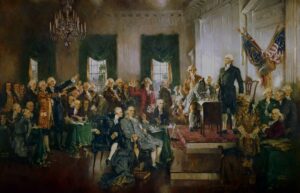What is the difference between originalism vs. textualism vs. living constitutionalism?

While we hear legal debates around originalism vs. textualism during high profile Supreme Court cases, they can often feel like vague terms. What exactly is originalism vs. textualism? The late Justice Antonin Scalia called himself both an originalist and a textualist. Justice Neil Gorsuch is considered “a proud textualist,” and yet he has called originalism “the best approach to the Constitution.” In 2010, Justice Elena Kagan told senators that in a sense, “we are all originalists.” Five years later in a speech at Harvard, she said, “We are all textualists now.”
So, is it truly originalism vs. textualism? Are originalism and textualism interchangeable? No. Textualism is a subset of originalism and was developed to avoid some of the messier implications of originalism as it was first described.
Originalism vs. textualism: Defining originalism
Originalism is a modest theory of constitutional interpretation rooted in history that was increasingly forgotten during the 20th century. It is modest because it doesn’t claim to rewrite the Constitution with grand pronouncements or faddish social theories. It simply calls for an understanding of the Constitution based on what the Constitution says.
Originalism’s revival in the 1980s was a reaction to the theory of the “Living Constitution.” That theory called for judges to interpret the Constitution, not according to its language, but rather according to evolving societal standards. In other words, judges shouldn’t focus on what the Constitution says, but what it ought to say if it were written today. When the Supreme Court engaged in living constitutionalism, the Justices could pretty much ignore its words. By the time we reached the 1960s, our living Constitution had become a mutating virus injected with the philosophical DNA of the interpreting jurists. By using living constitutionalism to rewrite laws in their own constitutional image, conservative scholars accused the Justices of the Warren Court of usurping the powers of the legislative branch.
It was against this backdrop that Ed Meese, Ronald Reagan’s attorney general, delivered a speech to the Federalist Society calling for a “jurisprudence based on first principles [that] is neither conservative nor liberal, neither right nor left. It is a jurisprudence that cares about committing and limiting to each organ of government the proper ambit of its responsibilities.” He accused living constitutionalism of being “a chameleon jurisprudence, changing color and form in each era.” Instead, he called for a manner of interpreting the Constitution based on its original language: in other words, originalism.
There were two slightly different understandings of originalism.
One is “original intent” that says we should interpret the Constitution based on what its drafters originally intended when they wrote it. The other is that we should interpret the Constitution based on the original meaning of the text—not necessarily what the Founders intended, but how the words they used would have generally been understood at the time.
Both versions of originalism—original intent and original meaning—contend that the Constitution has permanent, static meaning that’s baked into the text. Originalism, in either iteration, is in direct contravention of the “Living Constitution” theory.
When originalism was first proposed as a better alternative to living constitutionalism, it was described in terms of the original intention of the Founders. But when confronted with the difficulty, and indeed the inappropriateness, of trying to read the minds of the drafters of the Constitution, the advocates of originalism soon backed off talking about original intent, and instead focused on the original meaning of the words of the Constitution—an endeavor we now call textualism.
Originalism vs. textualism: Defining textualism
Textualism is the theory that we should interpret legal texts, including the Constitution, based on the text’s ordinary meaning. A textualist ignores factors outside the text, such as the problem the law is addressing or what the law’s drafters may have intended. But it does mean giving consideration to what the words and phrases in the text meant when a particular constitutional provision was adopted.
Textualism considers what a reasonable person would understand the text of a law to mean. It’s not to be confused with strict constructionism, which is a very literal close reading of the text. Justice Scalia called strict constructionism “a degraded form of textualism” and said, “I am not a strict constructionist, and no one ought to be.”
The best way to understand textualism—and how it differs from a strict constructionist’s hyper-literal reading—is through a case example Justice Scalia once presented:
The statute at issue provided for an increased jail term if, ‘during and in relation to … (a) drug trafficking crime,’ the defendant ‘uses … a firearm.’ The defendant in this case had sought to purchase a quantity of cocaine; and what he had offered to give in exchange for the cocaine was an unloaded firearm, which he showed to the drug-seller. The court held, I regret to say, that the defendant was subject to the increased penalty, because he had ‘used a firearm during and in relation to a drug trafficking crime’ … I dissented. Now I cannot say whether my colleagues in the majority voted the way they did because they are strict-construction textualists, or because they are not textualists at all. But a proper textualist, which is to say my kind of textualist, would surely have voted with me. The phrase ‘uses a gun’ fairly connoted use of a gun for what guns are normally used for, that is, as a weapon. When you ask someone ‘Do you use a cane?’ you are not inquiring whether he has hung his grandfather’s antique cane as a decoration in the hallway.
Textualism, in other words, does not rely on the broad dictionary-definition of each word in the text, but on how the words together would be understood by a reasonable person.
Originalism vs. textualism: Textualism avoids the trap of intent
If you were to understand originalism as looking at drafters’ original intent, then originalism is not compatible with textualism—because textualism by definition rejects extra-textual considerations like intent.
But the original intent version of originalism has mostly fallen out of favor. When Justice Gorsuch talks about originalism, he—like Justice Scalia—is referring to original meaning, which is compatible with textualism.
Once again, Justice Scalia did the best job of explaining this:
The theory of originalism treats a constitution like a statute, and gives it the meaning that its words were understood to bear at the time they were promulgated. You will sometimes hear it described as the theory of original intent. You will never hear me refer to original intent, because as I say I am first of all a textualist, and secondly an originalist. If you are a textualist, you don’t care about the intent, and I don’t care if the framers of the Constitution had some secret meaning in mind when they adopted its words. I take the words as they were promulgated to the people of the United States, and what is the fairly understood meaning of those words.
Under this definition of originalism, the theory maps very neatly onto textualism. The difference between them is one of scope, not philosophy: Originalism specifically refers to interpreting the Constitution based on the meaning the words carried at the time of writing, whereas textualism refers to interpreting all legal texts by the ordinary meaning of the text, setting aside factors not in the text itself.
Common good originalism: Living constitutionalism in originalist drag
Harvard Law School Professor Adrian Vermeule has recently challenged textualists with a new theory that he calls “Common Good Originalism.” He argues that conservative judges should infuse their constitutional interpretations with “substantive moral principles that conduce to the common good.” Textualists have not been amused, calling it nothing more than an embrace of the excesses of living constitutionalism dressed up in conservative clothing. William Pryor, former Alabama attorney general, claims that “the difference between … living constitutionalism and Vermeule’s living common goodism consists mainly in their differing substantive moral beliefs; in practice, the methodologies are the same.” The fundamental problem here is that one person’s moral principles that promote the common good are another’s anathema. If this is what Justices must base their opinions upon, we are back to the free-for-all of living constitutionalism.
Why this matters: Because originalism and textualism are essential to our liberties
Why should judges decide cases based on a centuries-old Constitution, as opposed to some more modern views of the relationship between government and its people? Why shouldn’t we trust Congress, the courts, or even the executive branch to determine what works best in modern times?
There have been various justifications for abiding by a centuries-old Constitution. There is the theory of consent—which seems more plausible for those who were around when the document was first drafted, rather than the present generations. There is a variation of this theory wherein we ratify the Constitution every time we vote, or least when we decide not to vote with our feet by moving elsewhere. This too seems more grounded in rhetoric than reality. Perhaps the most coherent justification for abiding by constitutional principles is that it seems to work. By taking seriously the concerns for liberty contained within the Constitution, we also may be less likely to govern by passion and focus more on long-term stability and freedom.
And it seems to work best if the Constitution is treated as a document with stable principles, ideals, and guidelines. When jurists insert their moral and philosophical predilections into the meaning of the Constitution, we can, and have, ended up with abominations like Korematsu v. United States (permitting the internment of Japanese citizens), Buck v. Bell (allowing the forced sterilization of women), Plessy v. Ferguson (condoning Jim Crow), and Dred Scott v. Sandford (allowing for the return of fugitive slaves after announcing that no African American can be a citizen), among others.
A fidelity to the original understanding of the Constitution should help avoid such excursions from liberty. That is because the Constitution was designed by men who adhered to John Locke’s theory that in the natural order of things, men possess liberty as a gift from their creator, not the result of government largesse. Government is formed precisely to protect the liberties we already possess from all manner of misguided policies that are inconsistent with the words of that great document that endeavored “to form a more perfect union, establish justice, insure domestic tranquility, provide for the common defense, promote the general welfare, and secure the blessings of liberty.” These words, and all those that follow, should be enough to stand as written, without embellishment with modern fads and conceits.





